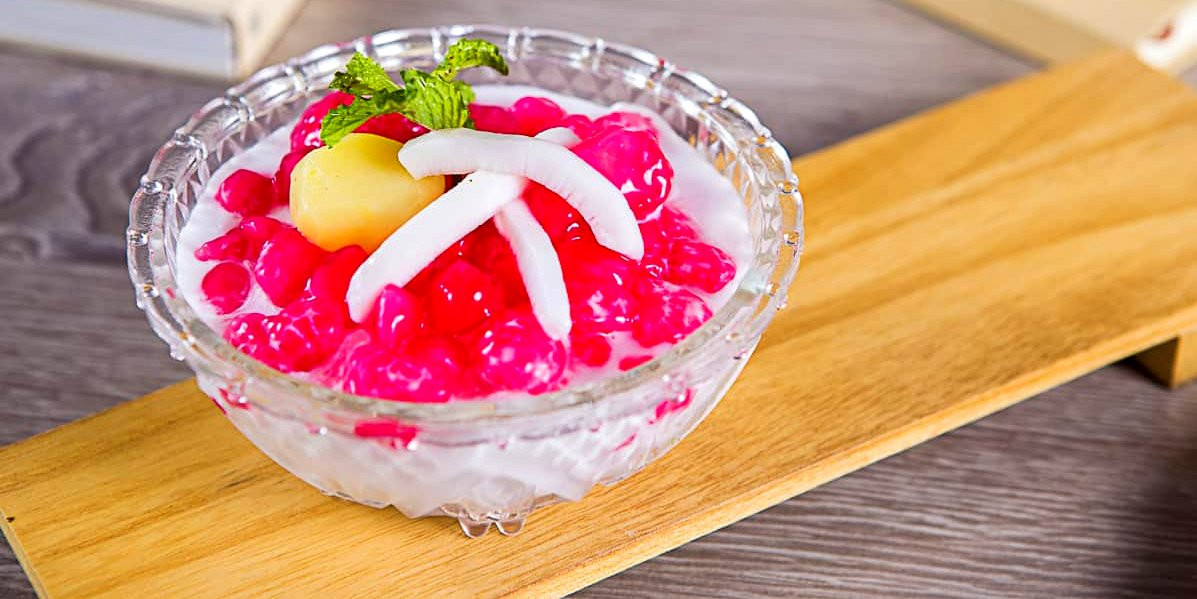Popular Thai Foods
Pad Thai
Pad Thai is one of Thailand's most iconic dishes, loved worldwide for its delightful mix of textures and flavors. This stir-fried noodle dish has a fascinating history and a recipe that can be adapted to various tastes, making it a versatile choice for any meal.
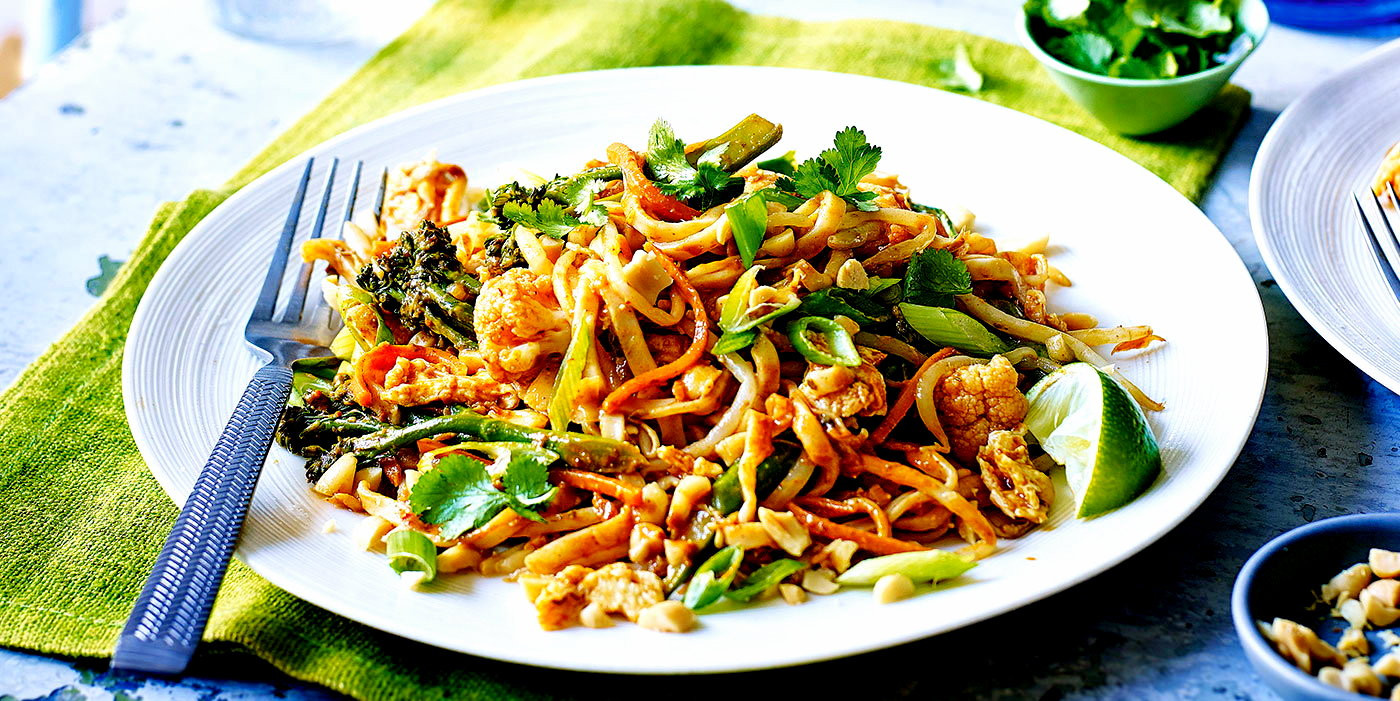
History of Pad Thai: Pad Thai was popularized during World War II in Thailand. The government of Prime Minister Plaek Phibunsongkhram promoted it as part of his campaign to increase nationalism and reduce domestic rice consumption amidst shortages. Made with rice noodles, Pad Thai was an economical, filling meal that utilized fewer staple grains. Its rise to fame was also due to its simplicity and the availability of its ingredients, which made it a popular street food.
Ingredients
The base ingredients for Pad Thai include:
-
Rice noodles: Typically thin, flat rice noodles, soaked until pliable before cooking.
-
Proteins: Common choices include shrimp, chicken, tofu, or a combination. For a vegetarian version, extra firm tofu can be substituted.
-
Eggs: Scrambled into the noodles during cooking.
-
Aromatics: Garlic and shallots are essential for the fragrant base.
-
Vegetables: Bean sprouts and garlic chives or green onions add crunch and freshness.
-
Nuts: Peanuts, often crushed, are sprinkled on top before serving.
Sauce
The unique taste of Pad Thai comes from its sauce, which traditionally includes:
-
Tamarind paste: Provides the signature tangy flavor.
-
Fish sauce: Adds saltiness and umami.
-
Sugar: Usually palm sugar, which balances the sourness of the tamarind.
-
Lime juice: Adds a touch of acidity, brightening up the dish.
Preparation
The cooking process is fast and requires everything to be prepared beforehand:
-
Noodles are soaked in warm water until they are just pliable but not soft.
-
Sauce ingredients are mixed together and set aside.
-
In a wok or large frying pan, aromatics are sautéed until fragrant, then proteins are added and cooked through.
-
Eggs are pushed to the side of the pan, scrambled until nearly cooked, then mixed with the proteins.
-
Drained noodles are added to the pan, along with the sauce. The mixture is stir-fried until the noodles are tender and have absorbed the sauce.
-
Bean sprouts and chives are mixed in and cooked briefly.
Serving: Pad Thai is typically garnished with a wedge of lime, crushed peanuts, fresh bean sprouts, and additional chives. It can be accompanied by condiments like chili flakes, extra fish sauce, and sugar, allowing each diner to customize the dish to their taste.
This dish not only represents the rich culinary tradition of Thailand but also its ability to adapt and evolve through history, making Pad Thai a beloved classic in global cuisine.
Tom Yum Goong
Tom Yum Goong is one of Thailand's most famous culinary exports, revered for its vibrant flavor profile that balances spicy, sour, salty, and sweet. This hot and sour soup epitomizes the essence of Thai cooking, with its aromatic components and bold tastes. Here’s an in-depth look at this beloved Thai dish.
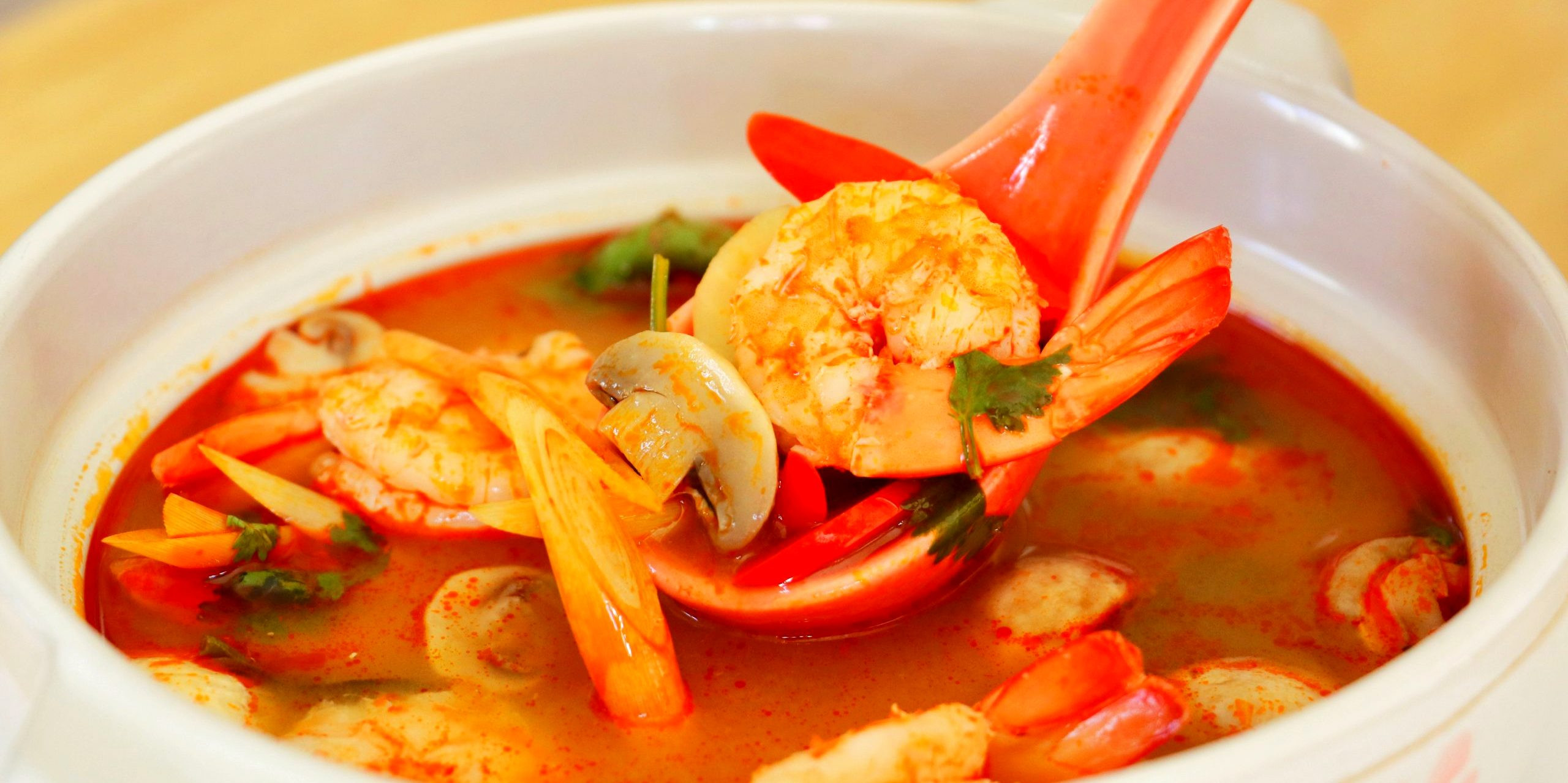
Overview of Tom Yum Goong: Tom Yum Goong translates to Thai spicy shrimp soup, and "Goong" specifically refers to the prawns that are a staple in this dish. It's a clear soup, though sometimes it's served as a creamy version with added coconut milk, known as "Tom Yum Goong Nam Khon". The soup's distinctive flavor is achieved through a variety of herbs and spices, combined with fresh shrimp.
Key Ingredients
The soup's unique taste is attributed to several key ingredients:
-
Shrimp (Goong): Fresh shrimp is essential for authenticity and flavor.
-
Lemongrass: This adds a citrusy fragrance that is crucial to the soup’s aroma.
-
Kaffir Lime Leaves: These leaves impart a piquant lime flavor that is unmistakably Thai.
-
Galangal: Similar to ginger but with a sharper, more citrusy flavor, galangal adds depth to the broth.
-
Fish Sauce: This provides the salty umami component that is foundational in many Thai dishes.
-
Chili Peppers: Fresh Thai chilies give the soup its characteristic heat.
-
Lime Juice: Freshly squeezed lime juice contributes the necessary sour component to the soup, balancing the heat from the chilies.
-
Mushrooms: Straw mushrooms are commonly used, though other varieties like oyster mushrooms can also be found in this soup.
Preparation
Preparing Tom Yum Goong involves simmering harder herbs like lemongrass, galangal, and lime leaves to infuse the water with their flavors before adding the other ingredients. Here’s a basic method:
-
Broth Base: Start by boiling water and then adding the lemongrass, galangal, and kaffir lime leaves. This mixture should simmer for a few minutes to release the flavors.
-
Add the Aromatics: Chili peppers and mushrooms can then be added. If you prefer a less spicy soup, the chilies can be lightly crushed instead of chopped to reduce the heat.
-
Incorporate the Shrimp: Once the broth is aromatic and flavorful, add the shrimp. Cook until they turn pink and are just cooked through.
-
Season the Soup: Add fish sauce and lime juice to taste, adjusting the balance until the desired harmony of sour, salty, spicy, and sweet is achieved.
-
Garnish and Serve: Fresh cilantro is often used as a garnish; additional lime wedges can be served on the side for an extra kick of sourness.
Variations: While Tom Yum Goong is traditionally made with shrimp, variations use other types of seafood or chicken. The creamy version of the soup includes a splash of coconut milk added towards the end of cooking, creating a richer, smoother broth.
Serving: Tom Yum Goong is typically served hot and is often a starter in a larger meal but it can also be a main course when served with rice. This soup is not only a treat for the taste buds but also considered healthy due to its potent combination of herbs and spices known for their beneficial properties.
Tom Yum Goong is a perfect example of Thai cuisine’s ability to engage all the senses, making it a must-try for anyone wanting to experience authentic Thai flavors.
Som Tam
Som Tam, also known as Thai green papaya salad, is a quintessential dish in Thai cuisine known for its explosive combination of flavors. It is incredibly popular not just in Thailand but globally, appreciated for its refreshing and vibrant taste profile. This dish perfectly captures the essence of Thai cooking with its harmony of sweet, spicy, sour, and salty flavors.
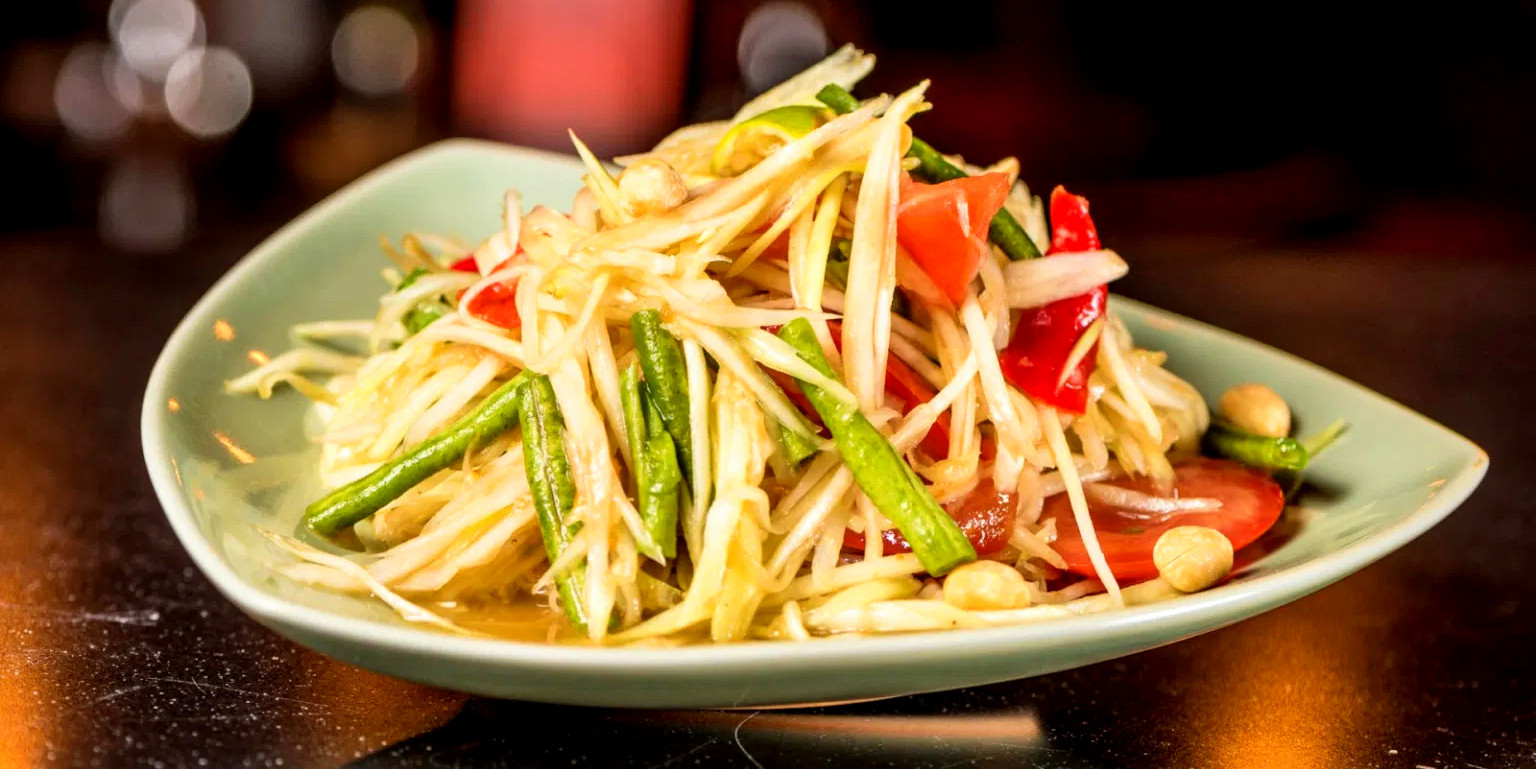
Overview of Som Tam: Som Tam originates from Northeastern Thailand (Isan), a region known for its bold and fiery flavors. The salad's main ingredient is unripe green papaya, which has a slightly tangy and crisp texture. It's a low-calorie dish that's also nutritious, offering a healthful mix of vitamins and fiber.
Key Ingredients
The classic Som Tam includes several key ingredients:
-
Green Papaya: Shredded into thin strips, it forms the base of the salad.
-
Tomatoes: Cherry tomatoes or regular tomatoes are halved or quartered.
-
Carrots: Sometimes added for extra color and texture, shredded like the papaya.
-
Peanuts: Roasted and crushed, they add a nutty crunch.
-
Lime Juice: Adds the essential citrusy sourness.
-
Fish Sauce: Provides the umami and saltiness.
-
Palm Sugar: Balances the dressing with its subtle sweetness.
-
Chilies: Thai bird-eye chilies give the salad its characteristic heat.
-
Garlic: A must for its pungent flavor.
-
Dried Shrimp: Optional, but adds a depth of flavor and texture.
Preparation: Making Som Tam involves pounding some of the ingredients in a mortar and pestle to release their flavors before mixing them with the rest. Here’s how it's typically prepared:
-
Pound the Flavor Base: Start by pounding the garlic and chilies together in a mortar. This step sets the spice level of the salad.
-
Add Small Ingredients: Add the dried shrimp (if using), fish sauce, lime juice, and palm sugar, continuing to pound gently to blend the flavors.
-
Mix in the Main Ingredients: Add the shredded green papaya, carrots, and tomatoes. Pound lightly and mix with a spoon or the pestle to combine everything without overly breaking the ingredients.
-
Garnish with Peanuts: Finally, toss in the roasted peanuts and give the salad a final mix.
Variations
While the classic Som Tam features green papaya, there are numerous regional variations:
-
Som Tam Thai: The most globally recognized version, often including peanuts and dried shrimp.
-
Som Tam Pla Ra: A version that includes fermented fish sauce, popular in northeastern Thailand for its robust flavor.
-
Som Tam with Crab: Incorporates salted or fresh crab into the mix, adding a seafood twist.
Serving: Som Tam is usually served as a side dish but can also stand as a light main dish, especially when paired with sticky rice or grilled chicken. It's typically eaten fresh, right after it's made, to enjoy the crispness of the papaya and the bright flavors of the dressing.
Som Tam not only reflects the flavors of Thailand but also its cultural emphasis on balancing different taste sensations in food. It’s a beloved dish that invites customization and is enjoyed by people around the world, adapting easily to different palates and preferences.
Green Curry
Green Curry, known as "Gaeng Keow Wan" in Thai, meaning "sweet green curry," is one of the most famous and sought-after dishes in Thai cuisine. Its name comes from the color of the dish, which is vividly green due to the fresh green chilies used in the curry paste. This curry is a perfect blend of sweet, creamy, and spicy flavors, offering a rich and aromatic experience.
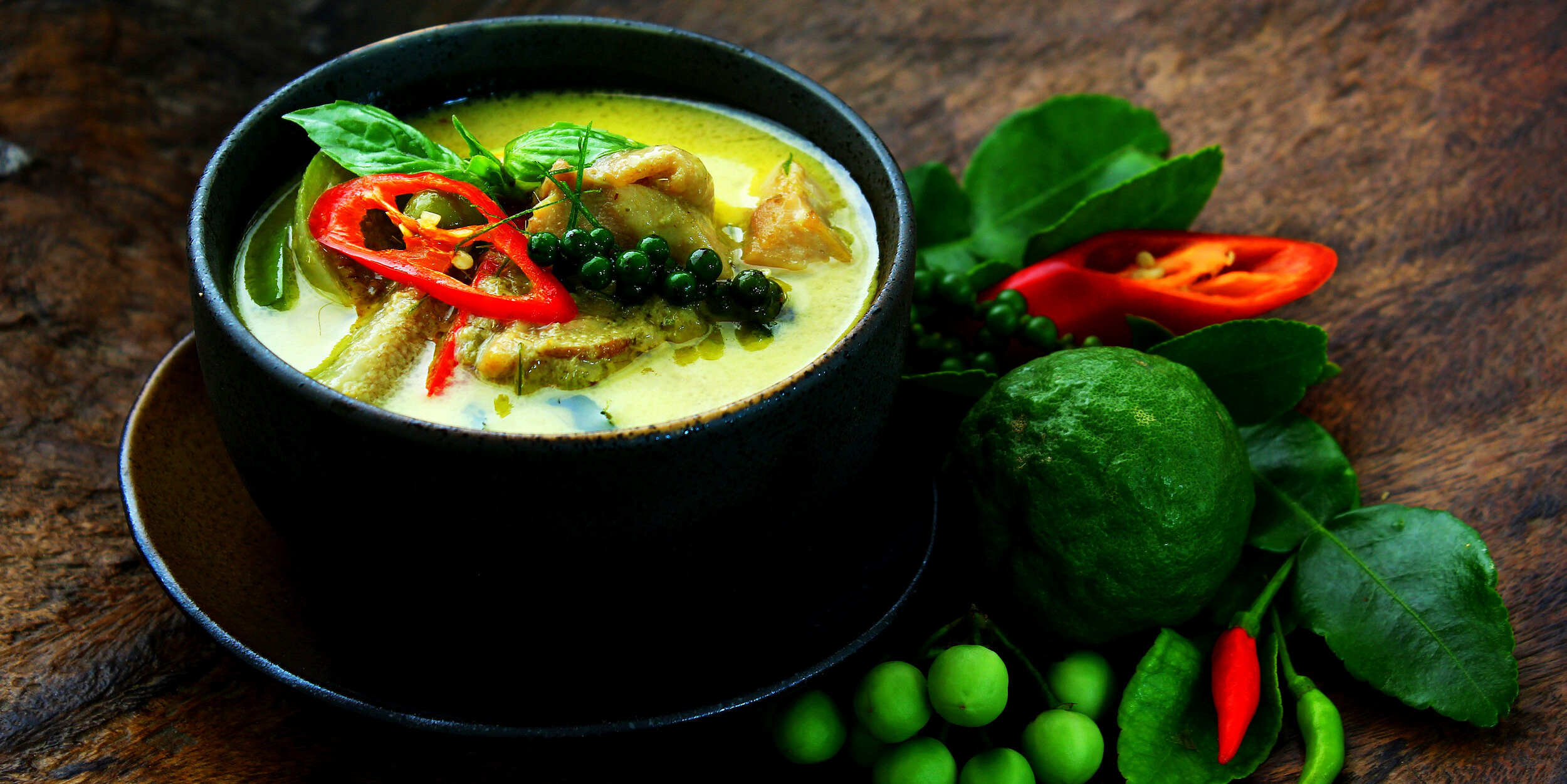
Overview of Green Curry: Green Curry is typically made with coconut milk, green curry paste, and a variety of meat options such as chicken, beef, pork, or fish, as well as tofu for a vegetarian version. The dish is colored and flavored by the green curry paste, which includes a mix of herbs and spices that give it a distinctive and vibrant flavor. It is often considered to be one of the spicier Thai curries, though it has a distinct sweetness thanks to the coconut milk and palm sugar.
Key Ingredients
The success of a good Green Curry lies in the quality of its ingredients, particularly the curry paste. Here are the essential components:
-
Green Curry Paste: Made from green chilies, shallots, garlic, galangal, lemongrass, kaffir lime zest, coriander roots, cumin seeds, and white peppercorns.
-
Coconut Milk: Provides the creamy base of the curry.
-
Meat or Tofu: Chicken is most common, but other proteins can be used.
-
Aubergines (Thai eggplants): These are traditional but optional.
-
Bamboo Shoots: Add texture to the curry.
-
Kaffir Lime Leaves: Impart a citrusy aroma.
-
Thai Basil: Adds a hint of sweetness and fragrance.
-
Fish Sauce: Enhances the umami flavor.
-
Palm Sugar: Balances the spice with a subtle sweetness.
Preparation
Creating Green Curry involves several steps to ensure the flavors meld perfectly:
-
Prepare the Curry Paste: If making from scratch, blend all the ingredients for the curry paste until smooth. Commercially available green curry pastes also work well and save time.
-
Cook the Paste: Heat a little coconut cream in a pan until it begins to separate, then add the green curry paste and fry until aromatic.
-
Add the Protein: Stir in your choice of chopped meat or tofu, ensuring it's well coated with the paste and begins to cook.
-
Simmer with Coconut Milk: Add the remainder of the coconut milk along with any other hard vegetables like bamboo shoots or Thai eggplants. Bring to a gentle boil and let simmer.
-
Season the Curry: Add fish sauce, palm sugar, and torn kaffir lime leaves. Adjust these elements depending on your taste preference for saltiness or sweetness.
-
Final Touches: Just before taking off the heat, add Thai basil leaves and any softer vegetables, if using.
Serving: Green Curry is typically served hot with steamed jasmine rice or, for a more authentic experience, with Thai sticky rice. This curry is also great with flatbreads or roti, which can be used to scoop up the rich sauce.
Green Curry embodies the heart of Thai culinary artistry, blending heat, sweetness, and a plethora of spices and aromatics. Each spoonful offers a burst of flavors that are robust yet harmoniously balanced, making it a beloved dish in both Thailand and around the world.
Massaman Curry
Massaman Curry, often spelled "Matsaman" or "Mussaman," is a unique and flavorful Thai curry that beautifully blends the spices commonly found in South Asian (especially Indian) cuisine with traditional Thai ingredients. It’s a richer, sweeter curry compared to other Thai curries, and it’s known for its mild spiciness, making it a favorite among those who prefer less heat.
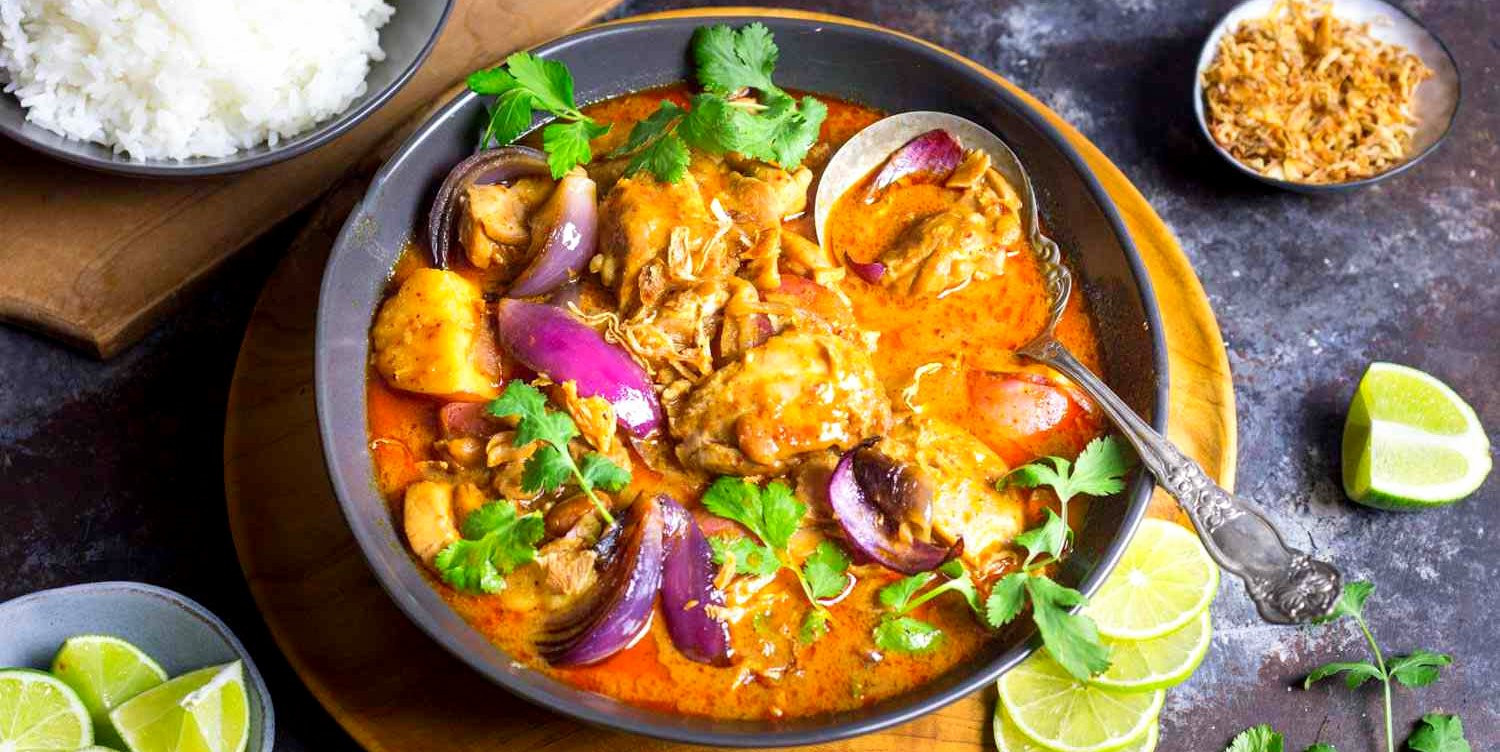
Overview of Massaman Curry: Massaman Curry is thought to have originated from Muslim traders who traveled to Thailand many centuries ago, and it has since become a beloved part of Thai cuisine. This dish is a perfect example of cultural integration, featuring a combination of spices like cinnamon, star anise, cloves, and nutmeg, which are not typically used in other Thai curries.
Key Ingredients
Massaman Curry’s distinctive flavor comes from its unique mix of ingredients:
-
Massaman Curry Paste: Typically made from a blend of dried red chilies, galangal, lemongrass, coriander seeds, cumin seeds, cloves, cardamom, cinnamon, and sometimes star anise.
-
Coconut Milk: Creates a creamy, rich base for the curry.
-
Meat: Beef is most traditional, but chicken and lamb are also used.
-
Potatoes and Onions: Essential for their texture and sweetness.
-
Peanuts or Cashews: Added for a nutty crunch.
-
Tamarind Paste: Provides a tangy flavor that balances the sweetness.
-
Fish Sauce: Adds depth and saltiness.
-
Palm Sugar: Sweetens the curry and enhances its deep flavors.
Preparation
Making Massaman Curry involves several steps to ensure each flavor is perfectly incorporated:
-
Fry the Curry Paste: Begin by heating a little oil in a pot and frying the curry paste until it's fragrant, which helps release the oils and aromas of the spices.
-
Add the Meat: Once the paste is ready, add your choice of meat and brown it slightly to lock in the flavors.
-
Simmer with Coconut Milk: Pour in coconut milk and bring the mixture to a gentle boil. Add potatoes and onions, then lower the heat and let the curry simmer slowly. This slow cooking process helps the meat become tender and flavors to develop fully.
-
Season the Curry: Incorporate tamarind paste, fish sauce, and palm sugar. Adjust these ingredients as needed to achieve a balanced mix of sweet, sour, and salty.
-
Add the Nuts: Towards the end of cooking, add peanuts or cashews for an added texture and richness.
Serving: Massaman Curry is typically served with jasmine rice, which helps absorb its rich flavors. It can also be enjoyed with roti or naan bread as an alternative. The curry is best when allowed to rest before serving, as this helps the flavors meld together more harmoniously.
Cultural Significance: The curry not only represents a fusion of culinary traditions but also a historical blend of cultures. It's often featured in global lists of favorite foods, highlighting its widespread appeal and the global palate's appreciation for Thai cuisine.
Massaman Curry is a testament to Thailand's ability to adopt and adapt influences from across the globe, creating dishes that are both uniquely Thai and universally beloved. Its complex flavor profile and comforting qualities make it a standout dish in Thai culinary offerings.
Popular Thai Desserts
Mango Sticky Rice
Mango Sticky Rice, known in Thai as Khao Niao Mamuang, is a classic and beloved dessert in Thailand, particularly famous during the mango season which peaks from April to June. This dessert is cherished for its simplicity, natural sweetness, and the harmonious combination of creamy, sticky rice with fresh, juicy mango.
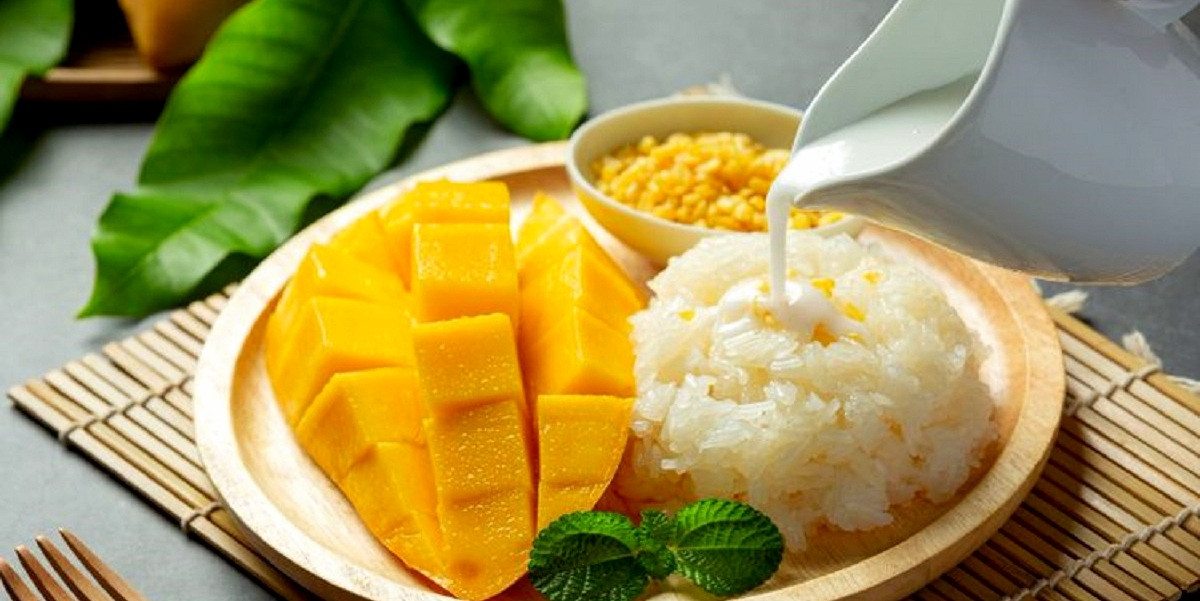
Ingredients of Mango Sticky Rice
The key components of Mango Sticky Rice are straightforward but require careful selection and preparation:
-
Glutinous Rice (Sticky Rice): The base of the dish, which becomes wonderfully sticky and chewy when cooked.
-
Ripe Mangoes: The quality of the mango is crucial. They should be sweet and ripe, commonly the 'Nam Dok Mai' variety is used in Thailand for its sweetness and velvety texture.
-
Coconut Milk: Used to infuse the sticky rice with creamy richness.
-
Sugar: Typically palm sugar is used for its subtle sweetness that complements the coconut.
-
Salt: A pinch of salt is crucial to balance and enhance the sweetness.
-
Sesame Seeds or Mung Beans: Often sprinkled on top for an added crunch and decorative touch.
Preparation of Mango Sticky Rice
The preparation of Mango Sticky Rice involves several steps to ensure each component blends perfectly:
-
Soak the Rice: The glutinous rice needs to be soaked in water for at least 4 hours, or overnight, to achieve the right texture upon cooking.
-
Steam the Rice: After soaking, the rice is drained and steamed until tender and translucent. Traditional Thai cooking uses a bamboo steamer for this purpose.
-
Prepare the Coconut Sauce: While the rice is steaming, coconut milk is heated with sugar and a pinch of salt, just until the sugar dissolves and the mixture is well combined.
-
Mix the Rice and Coconut Sauce: Once the rice is cooked, the warm coconut milk mixture is poured over it. The rice absorbs the coconut milk as it cools, becoming moist and flavorful.
-
Slice the Mango: The mango should be peeled and cut into thick slices. The slicing style can vary, but typically, they are either cut into long slender pieces or in a hedgehog pattern.
-
Serve: The coconut-infused sticky rice is served with fresh mango slices on the side. Sometimes, an additional drizzle of thick coconut cream and a sprinkle of toasted sesame seeds or mung beans is added on top for extra flavor and texture.
Cultural Significance: Mango Sticky Rice is more than just a dessert in Thailand; it's a dish that represents the bounty of the mango season and is a favorite during festive occasions and family gatherings. It is often enjoyed as a refreshing treat during the hot months, and its popularity has spread to many other countries, making it a global ambassador for Thai cuisine.
This dessert’s appeal lies in its delightful contrast of flavors and textures: the sweetness of the mango pairs beautifully with the salty-sweet and creamy sticky rice, creating a truly indulgent and satisfying experience. Mango Sticky Rice is a testament to the simple yet profound pleasures of Thai culinary traditions.
Khao Niao Mamuang
Khao Niao Mamuang, also known internationally as Mango Sticky Rice, is a beloved traditional Thai dessert, especially popular during the mango season which typically runs from April to June. This dessert is cherished not only for its delicious taste but also for its cultural significance in Thailand, symbolizing the arrival of summer and the abundance of fresh mangoes.
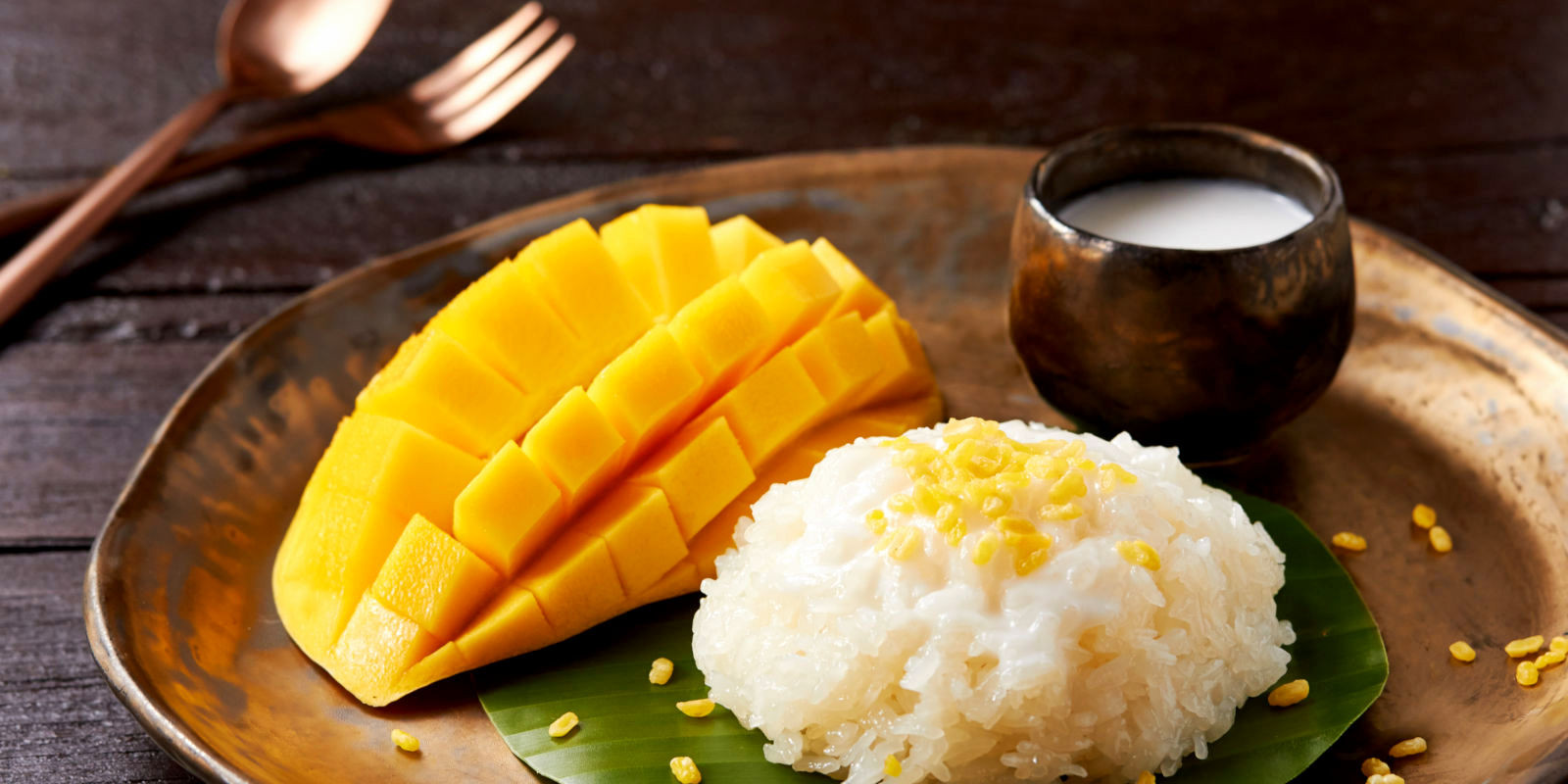
Components of Khao Niao Mamuang
The dish consists of just a few key ingredients, each playing a vital role in creating its distinctive taste and texture:
-
Glutinous Rice (Sticky Rice): This is the heart of the dessert, known for its sticky and chewy texture.
-
Ripe Mangoes: The mangoes should be sweet and ripe, with the Nam Dok Mai variety being the most preferred in Thailand due to its sweet, buttery flesh and minimal fibers.
-
Coconut Milk: This adds a creamy texture and rich flavor to the sticky rice.
-
Sugar: Usually palm sugar is used for its aromatic sweetness.
-
Salt: A small amount of salt is added to enhance the flavors.
-
Sesame Seeds or Mung Beans: These are optional but provide a crunchy contrast to the soft rice and mango when sprinkled on top.
Preparation Process
Creating Khao Niao Mamuang involves several careful steps to ensure the perfect balance of flavors and textures:
-
Rice Preparation: The glutinous rice must be soaked in water for several hours, typically overnight, to soften the grains and ensure even cooking.
-
Steaming the Rice: After soaking, the rice is drained and steamed until it becomes translucent and sticky. A traditional bamboo steamer is often used for this purpose to achieve an authentic flavor.
-
Making the Coconut Sauce: Simultaneously, coconut milk is heated with sugar and a pinch of salt, just until the sugar dissolves and the mixture is well combined. Some of the coconut milk is kept aside to be used as a topping before serving.
-
Marrying the Rice and Sauce: The warm, cooked sticky rice is then mixed with the sweetened coconut milk. It's important to do this while the rice is still hot so that it absorbs the coconut mixture thoroughly.
-
Mango Preparation: The mangoes are peeled and sliced into thick pieces. The presentation of the mango can vary, but elegance in slicing enhances the visual appeal of the dish.
- Assembly and Garnish: The coconut-infused sticky rice is served with fresh mango slices on the side. The dish is typically topped with the reserved thick coconut cream and sprinkled with toasted sesame seeds or mung beans for added texture.
Serving and Cultural Importance: Khao Niao Mamuang is often enjoyed as a cooling dessert during the hot months in Thailand. It's not just a treat for locals but a must-try for tourists, embodying the sweetness and hospitality of Thai culture. In Thailand, this dish is commonly available from street vendors to high-end restaurants, making it accessible to all who wish to indulge in its sweet, creamy goodness.
The simplicity of Mango Sticky Rice, combined with its rich flavors, makes it a perfect example of Thai culinary excellence. Its international popularity speaks volumes about its universal appeal, bridging cultures through the universal language of food.
Khanom Chan
Khanom Chan, often translated as "layered sweet" or "layered dessert," is a traditional Thai dessert that is not only delightful in taste but also striking in appearance. Known for its colorful, multi-layered structure, Khanom Chan is a favorite during celebrations and festive occasions in Thailand due to its aesthetic appeal and its symbolic significance of prosperity and progression.

Ingredients of Khanom Chan
The main components of Khanom Chan are quite simple, which belies the complexity of its preparation and the beauty of the final product:
-
Tapioca Flour: The primary ingredient that gives Khanom Chan its characteristic chewy texture.
-
Rice Flour: Sometimes combined with tapioca flour to adjust the texture.
-
Coconut Milk: Provides creaminess and rich coconut flavor.
-
Sugar: Adds sweetness to the dessert.
-
Pandan Leaves: Often used to flavor and color the dessert naturally, giving it a vibrant green color and a fragrant aroma.
-
Food Coloring: Additional colors may be added to create more vibrant layers, although traditional recipes rely on natural color sources like pandan, butterfly pea flower, or turmeric.
Preparation Process
Making Khanom Chan involves a meticulous process to ensure that each layer sets perfectly before the next one is added:
-
Make the Mixture: Combine coconut milk, tapioca flour, rice flour, sugar, and pandan juice (if using) in a pot. This mixture needs to be stirred continuously and cooked over low heat until it thickens slightly.
-
Coloring the Layers: Divide the mixture into different bowls if using multiple colors. Each portion can be colored with natural or artificial food colorings.
-
Steam in Layers: Start by pouring a small amount of one color of the mixture into a well-greased pan. Steam each layer for about 5 to 10 minutes until it is set but still sticky on top.
-
Add Subsequent Layers: Once a layer is set, carefully spoon another layer of a different color on top and steam again. Repeat this process until all layers are used. Typically, Khanom Chan consists of 9 or more layers.
-
Cool and Set: After the final layer is added and steamed, let the dessert cool down completely and set in the pan. This could take several hours.
Serving: Khanom Chan is cut into pieces, often diamonds or squares, and served at room temperature. The layers should be distinct and slightly firm, offering a chewy texture that is highly prized in many Asian desserts.
Cultural Significance: The dessert's layered nature is thought to represent prosperity, advancement, and beauty, making it particularly popular at weddings, housewarming parties, and other celebrations. Its preparation, requiring patience and precision, is a labor of love and a testament to the skill of the dessert maker.
Khanom Chan is a perfect example of the Thai aesthetic in cuisine, where food is not only meant to satisfy the palate but also to delight the eye and represent deeper cultural values. This dessert’s popularity has endured over generations, securing its place as a cherished tradition in Thai culinary heritage.
Foi Thong
Foi Thong, which translates to "golden threads," is a beloved Thai dessert that is as visually appealing as it is delicious. This exquisite dessert has its roots in Portuguese cuisine, specifically influenced by the Portuguese dessert "fios de ovos." It was introduced to Thailand in the 16th century by Maria Guyomar de Pinha, a woman of Japanese-Portuguese-Bengali descent who married a Greek man involved in the Siamese court. Foi Thong has since become a staple in Thai culinary tradition, particularly during auspicious occasions and celebrations.
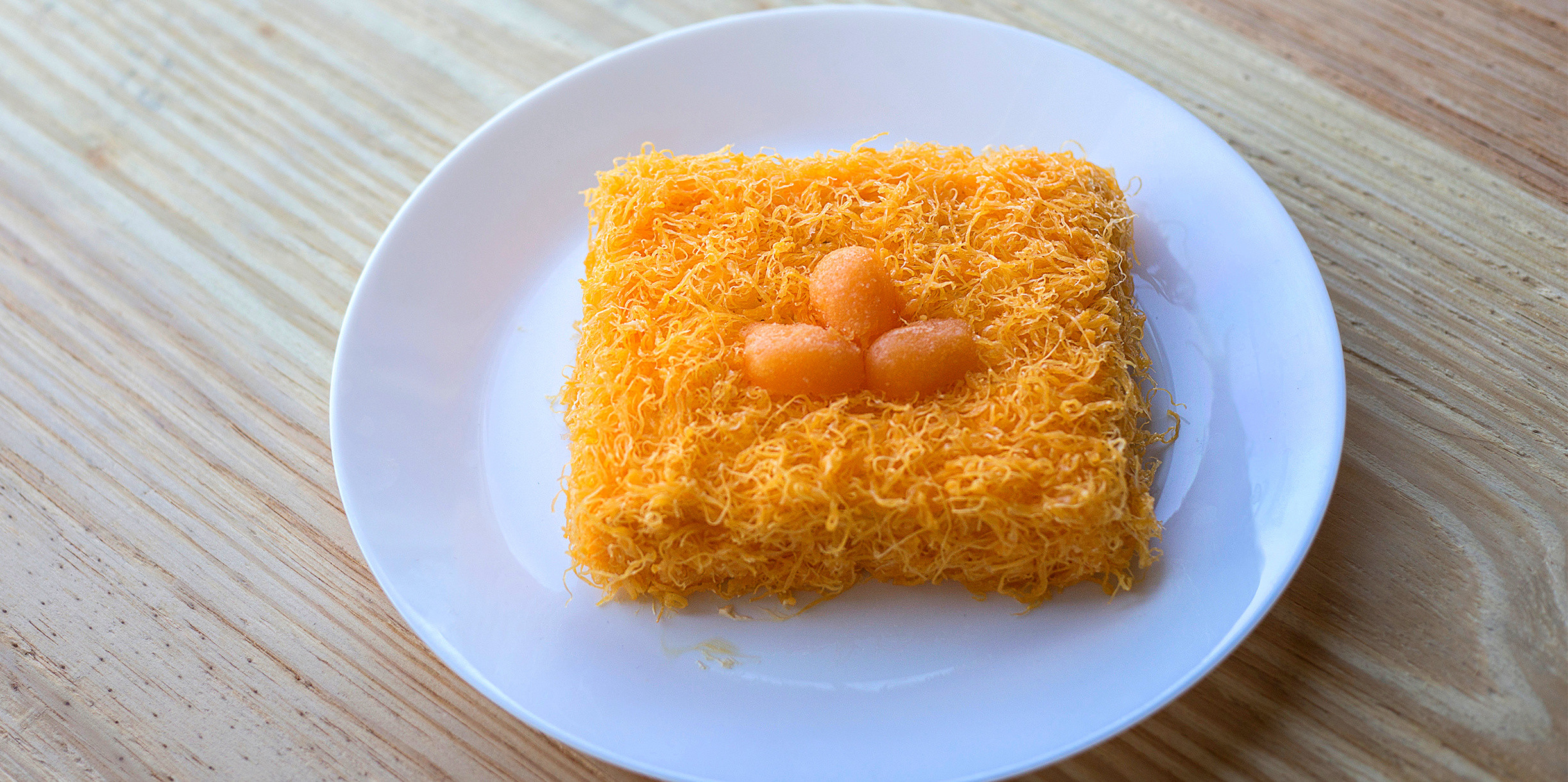
Ingredients of Foi Thong
The primary ingredients in Foi Thong are simple, focusing on egg yolks and sugar, which are transformed through a meticulous cooking process into golden, syrup-coated threads:
-
Egg Yolks: The main component, used after being carefully separated from the whites.
-
Sugar: Creates the syrup in which the threads are cooked.
-
Water: Used to dissolve the sugar and form the syrup.
-
Jasmine Water: Occasionally added for an aromatic touch.
Preparation Process
The preparation of Foi Thong is an art form that requires patience and technique to produce thin, delicate strands of egg yolks:
-
Prepare the Syrup: Sugar and water are boiled together to create a light syrup. The syrup must reach the perfect consistency—not too thick, so it can coat the egg threads lightly without weighing them down.
-
Egg Yolks: Egg yolks are beaten lightly and then strained through a fine sieve to remove any lumps, ensuring the smoothness necessary for fine threads.
-
Creating the Threads: The strained yolks are poured slowly through a funnel or a special perforated ladle with large holes, held high above the hot syrup. As the yolk hits the syrup, it cooks immediately, forming thin golden threads.
-
Gently Stirring: The threads must be gently stirred in the syrup to prevent them from clumping together, ensuring each thread remains separate and gets evenly coated with syrup.
-
Cooling and Storing: Once cooked, the Foi Thong is removed from the syrup and allowed to cool. The threads should be shiny, golden, and have a slightly chewy texture.
Serving and Cultural Significance: Foi Thong is often served as part of a larger dessert platter or used as a decoration on other desserts, such as cakes or puddings. In Thai culture, its golden color is highly auspicious, symbolizing wealth, prosperity, and good fortune, making it a popular dish during celebrations such as weddings, Songkran (Thai New Year), and other festive occasions.
Storage: Foi Thong can be stored in syrup in airtight containers to maintain its texture and flavor for several days, allowing it to be enjoyed well beyond its day of preparation.
Foi Thong is a testament to the intricate and refined nature of Thai desserts, reflecting both the cultural heritage and the culinary sophistication that Thai cuisine is known for. Its preparation is a labor of love, often reserved for special occasions where its golden, lustrous appearance can truly shine.
Thapthim Krop
Thapthim Krop, translated as "rubies in coconut milk," is a classic and visually stunning Thai dessert. Known for its jewel-like appearance, this dessert features chewy water chestnuts coated in a bright red jelly, which are then served in a sweet, aromatic coconut milk. The name, often associated with pomegranate seeds or rubies due to the dessert's striking red color, makes Thapthim Krop not only a delight to eat but also a pleasure to behold.
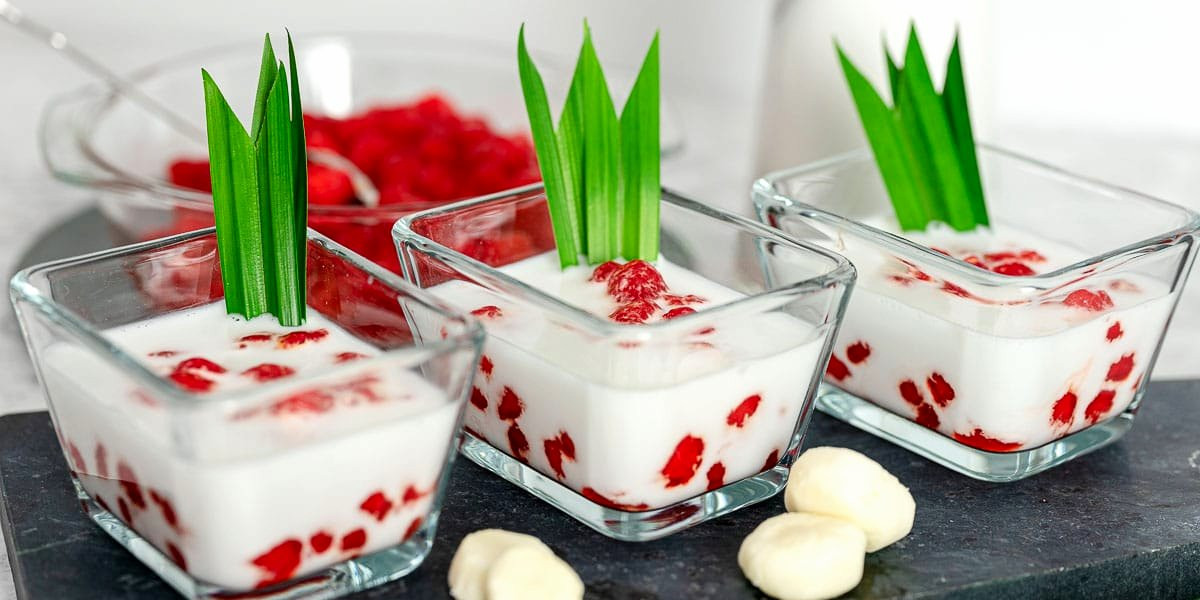
Ingredients of Thapthim Krop
The preparation of Thapthim Krop involves simple ingredients that come together to create a delightful and refreshing dessert:
-
Water Chestnuts: The core ingredient, these are diced into small cubes to resemble rubies.
-
Tapioca Flour: Used to coat the water chestnut cubes, giving them a chewy, jelly-like texture.
-
Red Food Coloring: This is used to dye the tapioca-coated chestnuts, enhancing their ruby-like appearance.
-
Coconut Milk: Forms the creamy base in which the rubies are served.
-
Sugar: Sweetens the coconut milk.
-
Salt: A pinch is added to the coconut milk to balance the sweetness.
-
Crushed Ice: Often served with the dessert to make it more refreshing, especially ideal in hot weather.
Preparation Process
Creating Thapthim Krop involves several steps, each essential to achieving the perfect texture and appearance:
-
Prepare the Water Chestnuts: Start by peeling and chopping the water chestnuts into small cube-sized pieces.
-
Coat and Color: Mix the tapioca flour with red food coloring. Roll the chopped water chestnuts in this mixture until they are well coated.
-
Cook the Chestnuts: Boil the coated water chestnuts in water until they float to the surface and become translucent. This indicates that the tapioca has cooked and formed a jelly-like coating around each piece.
-
Prepare the Coconut Milk: Simmer coconut milk with sugar and a pinch of salt just until the sugar dissolves. Allow it to cool to room temperature.
-
Assemble the Dessert: Place the cooked water chestnuts in a serving bowl, pour the sweetened coconut milk over them, and add crushed ice if desired.
Serving: Thapthim Krop is typically served chilled, making it an especially popular treat in the tropical heat of Thailand. The combination of sweet, creamy coconut milk with the chewy, crisp texture of the tapioca-coated water chestnuts offers a delightful contrast.
Cultural Significance: This dessert is often found at Thai festivals and celebrations, admired as much for its beauty as for its taste. The vibrant red color and the name's association with precious gems convey wishes of prosperity and good fortune to those who enjoy it.
Thapthim Krop is a perfect example of the creativity and cultural richness of Thai desserts, combining aesthetic appeal with delicious flavors and textures. It's a testament to the playful and innovative spirit of Thai cuisine, where even simple ingredients are transformed into a dish that is both a feast for the eyes and a treat for the palate.
Thai cuisine offers a rich tapestry of flavors and textures, celebrated worldwide for its depth and diversity. From the vibrant tang of Pad Thai to the sweet indulgence of Mango Sticky Rice, each dish not only delights the palate but also embodies Thailand's rich cultural heritage. Thai food and desserts balance complex flavors with exquisite presentation, making every meal a celebration of both tradition and innovation. Whether enjoyed in a bustling street market or a fine dining restaurant, Thai cuisine provides a captivating culinary experience that continues to enchant food lovers globally.
FAQs for Popular Thai Cuisine and Desserts
Q: What are some must-try Thai dishes for beginners?
A: Beginners should start with Pad Thai, Green Curry, and Tom Yum Goong. These dishes exemplify the essential flavors of Thai cuisine: sweet, sour, salty, and spicy.
Q: What makes Thai food unique?
A: Thai food is distinguished by its balance of five fundamental flavors: sour, sweet, salty, bitter, and spicy. Key ingredients like fish sauce, lemongrass, galangal, and lime offer distinctive tastes unique to Thai cuisine.
Q: Are there vegetarian options in Thai cuisine?
A: Yes, there are many vegetarian options available, such as Tofu Pad Thai, Vegetable Green Curry, and Som Tam (prepared without fish sauce or shrimp). Many Thai desserts, which utilize coconut milk and tropical fruits, are also naturally vegetarian.
Q: What are some common ingredients in Thai desserts?
A: Typical ingredients in Thai desserts include coconut milk, sticky rice, tapioca, tropical fruits like mango and durian, and sweeteners such as palm sugar.
Q: How is Thai street food different from restaurant offerings?
A: Thai street food is typically quicker and more casual, often reflecting local flavors and seasonal ingredients. In contrast, restaurant offerings might be more refined, featuring a broader array of dishes including regional and royal Thai cuisine.
Q: What Thai dessert is considered a classic and why?
A: Mango Sticky Rice is a classic Thai dessert because it perfectly balances the creamy, sweet sticky rice with fresh mango, embodying the simplicity and harmony favored in Thai desserts.
Q: Can Thai food be spicy, and how can I request milder options?
A: Thai food can indeed be very spicy, but most dishes can be adjusted to milder levels. To request less spicy food, you can say "mai phet" (not spicy) when ordering.
Q: Is Thai cuisine suitable for those with food allergies?
A: Thai cuisine frequently uses allergens like nuts, shellfish, and gluten (found in soy and oyster sauces), which can be problematic. Always inform your server of any allergies and inquire about ingredients before ordering.
Q: How do Thais typically enjoy their meals?
A: Meals are often enjoyed family-style in Thailand, with multiple dishes shared from the center of the table, typically using a fork and spoon rather than chopsticks.
Q: What should I know about Thai dessert etiquette?
A: Thai desserts are commonly shared, especially in group settings. It’s customary to take small portions to ensure everyone can enjoy a variety of tastes.
For the Nepal tour, please click here.
If you are looking for different kinds of Nepal Tours or Trekking Packages, feel free to contact us.
